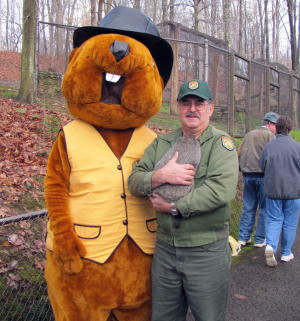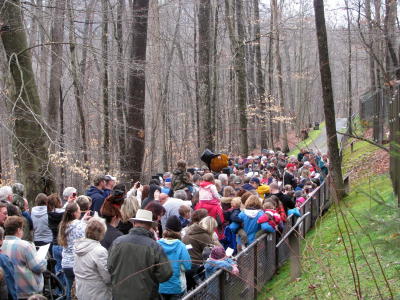
Gary Hissam of the West Virginia Wildlife
Center is Freddie's handler. He raised the
current Freddie from a baby since summer of 2011
FRENCH CREEK, W.Va. - West Virginia State Wildlife Center's official weather prognosticator, French Creek Freddie, is poised to forecast the onset of spring on Saturday, Feb. 2, 2013 at 10 a.m. French Creek Freddie has undertaken his annual ritual at the West Virginia State Wildlife Center since 1978.
"Celebrating Groundhog Day at the Wildlife Center has become a very popular event," said Wildlife Center Biologist Gene Thorn. "This year we're hoping for a huge crowd to help us celebrate and witness Freddie's annual prediction because the event falls on Saturday when the kids are out of school."
In addition to the pageantry of seeing if Freddie sees his shadow, visitors can listen to poems and songs, enjoy refreshments, and compete in various wood chuckin' contests.

Crowd at the 2012 Groundhog Day celebration
at the West Virginia Wildlife Center
According to tradition rooted in early European legend, Groundhog Day stems from similar beliefs associated with Candlemas Day. For centuries, early Christian clergy would bless candles and distribute them to the people. During the conquest of the northern country, Roman legions supposedly brought this tradition to the Germans, who concluded that if the sun made an appearance on Candlemas Day, the hedgehog would cast a shadow, thus predicting six more weeks of bad weather. The Germans would recite: For as the sun shines on Candlemas Day, so far will the snow swirl until the May.
Early German settlers in the New World found another burrowing animal, the woodchuck or groundhog, to be more plentiful then the hedgehog. Thus, the groundhog replaced the hedgehog as the traditional "wise animal" in North America.
Freddie's legend launched in 1978
People remember retired West Virginia Wildlife Center biologist Bill Vanscoy for his annual tete-a-tete with French Creek Freddie, the Wildlife Center's resident weather-prognosticating groundhog. Vanscoy in fact launched Freddie's legend in 1978.
According to Vanscoy, "A newspaper reporter who had come to the Game Farm (now the Wildlife Center) called me the day before Groundhog Day one year and asked if we had a groundhog, and if it had seen its shadow. I don't remember what I told him, but it was whatever was appropriate to the weather we were having.
"Anyway, he asked me what the groundhog's name was. I don't know what possessed me to do it, but I skipped the usual lecture on why we don't name animals and said his name was French Creek Freddie. It went out on the Associated Press wire, and soon we were getting calls from all over the country. Every year now, people from newspapers and TV stations come out on Groundhog Day and get a groundhog out of its den for the cameras. It's harmless fun, and it comes at a time of the year that people need some cheering up."
The next Wildlife Center biologist, Rob Silvester, continued the tradition and recalls that people from the region remembered seeing him on TV with French Creek Freddie. "I would be walking in the mall in Fairmont and some guy would come up to me and say he saw me on TV on Groundhog Day."
Current Wildlife Center biologist Gene Thorn has experienced the same thing as he carries on the tradition each year. He has expanded the ceremony into a lesson on the history of Groundhog Day - reading poems sand leading songs, including one he wrote himself, "The French Creek Freddie Song," sung to the tune of the "Mickey Mouse March" that many in the crowd grew up with.
There are refreshments, games and activity sheets for the kids. This year a Wood Chuckin' Contest will be held. The local community gets involved, and every year the local Lion's Club puts on a Pancake and "Ground-hog" Sausage Feed at the Volunteer Fire Department in Rock Cave. A good time is had by all that show up at 10 a.m. Feb. 2 each year.
For more information about the annual Groundhog Day Celebration at the West Virginia State Wildlife Center, contact the center at (304) 924-6211 or visit the DNR's web page at www.wvdnr.gov
| 


